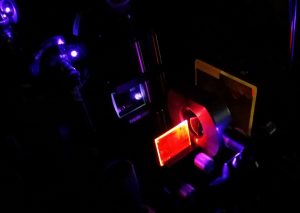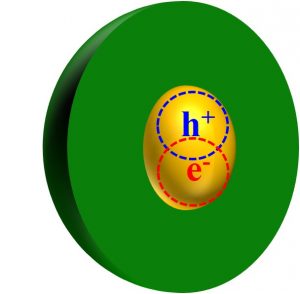
Lasing from core/shell giant CdSe/CdS quantum dots.
Colloidal nanomaterials typically exhibit large absorption cross sections and tunable, narrow band, and highly efficient photoluminescence. These characteristics turn them optimum candidates for lighting applications, such as LED´s and lasers. Nevertheless, to date, their performance is less than ideal, mostly due to nonradiative processes which are more pronounced in devices than in solution.
Consequently, controlling electron and hole interactions in nanomaterials is one of the most current challenges in the quantum dot field. Here, we investigate how we can manipulate electronic wavefunctions by engineering new heterostructured nanomaterials in order to enhance their emission properties.

Schematic of a type-I core/shell quantum dot
In our group, we are interest on understanding how structural changes affect the electronic interactions in a number of heterostructured nanomaterials, among them: type-I (CdSe/ZnS and CdSe/CdZnS), and quasi type-II (CdSe/CdS and PbS/CdS) core/shell quantum dots and multi-shell structures, such as CdS/CdSe/CdS spherical quantum wells. By changing composition and core or shell dimensions, it is possible to engineer the electron and hole wavefunctions in order to maximize or minimize their overlap, controlling radiative decay and nonradiative processes, in particular Auger recombination and photo-ionization. As shown in the figure above, it is possible to reach low threshold amplified stimulated emission with these engineered nanostructures.
